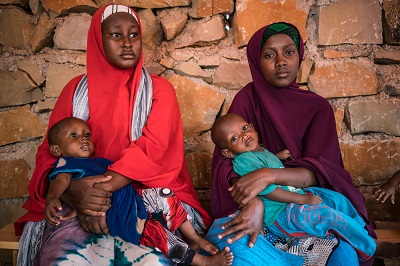Projected number of severely malnourished Somali children up 50 percent
Somali children face triple threat of drought, disease and displacement
The projected number of children who are or will be acutely malnourished has shot up by 50 per cent since the beginning of the year to 1.4 million, including over 275,000 who have or will suffer life-threatening severe acute malnutrition in 2017.

Young mothers wait with their children to be seen at a UNICEF-supported outpatient therapeutic center in Garbaharey, Somalia.
Severely malnourished children are nine times more likely to die of killer diseases like cholera / acute watery diarrhea and measles, which are spreading. During the 2011 famine in Somalia that killed an estimated 260,000 – over half of them young children – the main causes of death among children were diarrhea and measles.
“UNICEF and partners have treated over 56,000 severely malnourished children so far this year – almost 90 per cent more than the same period in 2016,” said Steven Lauwerier, UNICEF Somalia Representative. “But the combination of drought, disease and displacement are deadly for children, and we need to do far more, and faster, to save lives.”
Around 615,000 people, the vast majority of them women and children, have been displaced by drought since November 2016.
The Gu (April-June) rains are slowly unfolding, bringing much needed relief to parts of the country. But the rains also spell danger for children. If they come in full they will inflict further misery on children living in flimsy, makeshift shelters made of twigs and cloth or tarps. If the Gu rains fail, and if assistance doesn’t reach families, more people will be forced off their land into displacement camps. Outbreaks of malaria are already imminent, as is an upsurge of cholera.
“New population movements will further aggravate the situation. Those who remain at home need urgent assistance so that they do not need to flee; and those who have already fled, and are now in camps, are extremely vulnerable – children most of all,” Lauwerier said.
The women and children who make the trek, generally on foot, to places where they hope to find assistance, are often robbed or worse, both on the way to, and in camps. While there have been some reports of sexual abuse, including rape, most women do not come forward due to the stigma associated with rape and fear that their husbands will learn of it. Perpetrators of sexual violence are seldom punished.
The drought has also forced some 40,000 children to stop attending classes, as the most vulnerable families enlist children to search for water, or as they migrate in search of food and water. There is anecdotal evidence of more children living on the street, and of displaced children being recruited into armed groups.
Early planning and funding has made a huge scale up in assistance possible. UNICEF and partners:
• Support 64 cholera treatment facilities that have treated more than 28,400 cases as of 23 April, compared with some 15,600 cases treated during all of 2016.
• Have set up and support 330 new nutrition centres, bringing the total to 837 across the country. These sites have made it possible to treat 56,054 children suffering from SAM since the beginning of the year, almost double the number of admissions over the same period in 2016, with a 92 per cent recovery rate.
• Provide more than 1 million people affected by drought with temporary access to safe water, up from some 300,000 in January.
• Reached over 380,000 children and women with life-saving health services including emergency vaccinations, through support to over 100 health centres and 60 mobile and outreach services.
• Provided 190 schools reaching almost 20,000 children with safe drinking water; set up temporary learning spaces enabling 43,000 children to learn; and provided emergency cash grants to almost 10,000 children at highest risk of dropping out.
• Provided 840 unaccompanied and separated children, and 1,184 survivors of gender-based violence with critical services.
UNICEF has received $78.7 million of its $148 million appeal – a 47% gap in funding.
Source:United Nations Chidldren's Fund
- 310 reads
Human Rights
Ringing FOWPAL’s Peace Bell for the World:Nobel Peace Prize Laureates’ Visions and Actions

Protecting the World’s Cultural Diversity for a Sustainable Future

The Peace Bell Resonates at the 27th Eurasian Economic Summit

Declaration of World Day of the Power of Hope Endorsed by People in 158 Nations

Puppet Show I International Friendship Day 2020

